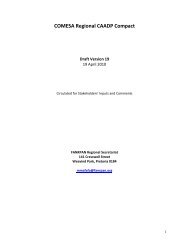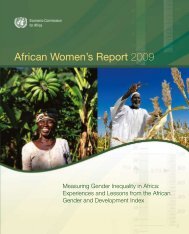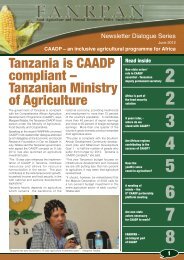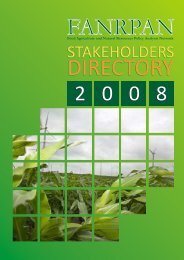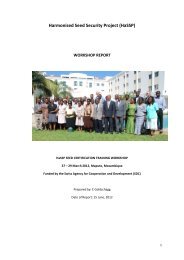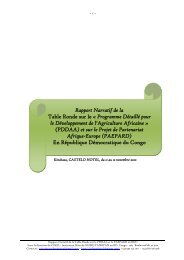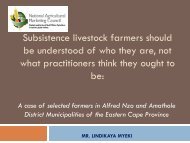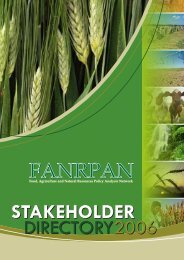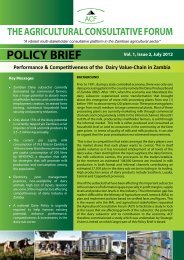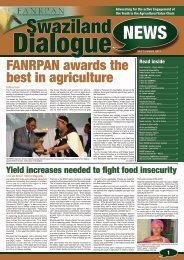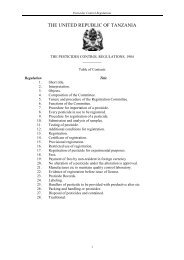Community-driven development decision tools for rural - IFAD
Community-driven development decision tools for rural - IFAD
Community-driven development decision tools for rural - IFAD
- No tags were found...
You also want an ePaper? Increase the reach of your titles
YUMPU automatically turns print PDFs into web optimized ePapers that Google loves.
IIIPoverty focus of CDD<strong>IFAD</strong>’s special poverty focusAlthough all <strong>development</strong> agencies claim that their CDD interventions focus on poverty, <strong>IFAD</strong> placesconsiderable emphasis on distributional aspects and related targeting issues. Other agencies tend todisregard these aspects; they may, <strong>for</strong> example, assume that targeting <strong>rural</strong> areas is a sufficient focuson poverty because “<strong>rural</strong>” is synonymous with “poor”. They may also believe that poverty reductionis better achieved by the trickle-down effects of financing the production of public goods andmeasures generally aimed at income and productivity growth.For <strong>IFAD</strong> the matter is more complex because of its specific mandate. Since CDD entrusts thecommunities with <strong>decision</strong>s about <strong>development</strong> interventions, the questions <strong>for</strong> <strong>IFAD</strong> are as follows:how targetable is CDD? What mechanisms would ensure that <strong>decision</strong>s made at the communitylevel do not sideline the interests of the lowest social strata of the community and do not excludethem from a fair share of the opportunities from project interventions?To address this question, <strong>IFAD</strong> projects often focus on how to• select poor communities within an area of intervention;• reach the poor within the selected communities without jeopardizing the CDD principle thatempowers the communities to set the agenda of the interventions.Selecting poor villagesPoor villages can be selected using transparent parameters. An example of one such parameter isfood security. (Data on village food security are collected by some governments with the assistance ofspecialized UN agencies, such as the Food and Agriculture Organization of the United Nations [FAO]and the World Food Programme [WFP], although they usually aggregate data at the district orsubdistrict level). This parameter provides a first approximation <strong>for</strong> poor villages and is widely used,but it has serious drawbacks. For example, a village that produces few food crops but whoseinhabitants derive their livelihood from cash crops or handicraft activities would not be classified asfood secure, however, it is not necessarily poor; on the contrary, a wealthy village often achieves foodsecurity through trade.While more sophisticated indices of poverty can be constructed at a cost, data on poverty indicesare seldom available at the village level. Even if they could be estimated <strong>for</strong> a single point in time,keeping the data updated is not practically possible. As a result, the selection of poor villages is oftenmade using food security criteria, taking into account the most obvious cases where alternative orcomplementary sources of livelihood are available to the village. 11<strong>IFAD</strong> projects tend to fund successive phases of <strong>development</strong> in the same project area. Thisprovides in<strong>for</strong>mation about a village’s per<strong>for</strong>mance under a previous <strong>IFAD</strong> project 12 , which can beused to fine-tune the assessment about the village and to adjust the project design based on theexperience in the area.Assessing community needs and assetsA needs assessment process has traditionally been used to identify communities eligible <strong>for</strong>assistance. This process <strong>for</strong>mally identifies the gaps between the basic services that should beavailable to members of a community according to government policy and those that are actuallyaccessible to them. In accordance with the principle of providing equal services to all,11 FAO’s definition of food security takes into account the quantity of food produced, the stability of production and the access topurchase food to meet local deficiencies.12 See Senegal <strong>IFAD</strong> Projet d’organisation et gestion villageoise, second phase (POGV II).24



